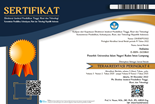Dynamics of Muslim Adolescent Aggression: The Relationship Between Religiosity and Aggression and Peer Religion as Moderator
Abstract
Adolescence is a critical period marked by significant physical, cognitive, and socio-emotional changes. In Indonesia, adolescent’s aggression is a problem influenced by various factors, such as internet addiction, poor emotional regulation, anxiety, peers influence, and parenting styles. Therefore, during this period, relationships with peers become increasingly important as young people strive to be independent and have a sense of belonging. The study population of 238 people was obtained through an initial questionnaire collected on July 25, 2024 - August 20, 2024. The use of covariance-based SEM with parametric assumptions that the research variables must meet the assumption of a normal multivariate distribution. However, the research variables did not meet the assumption of normality, so Partial Least Square (PLS) was used. The hypothesis testing method used Structural Equation Modeling (SEM) with SmartPLS 4.00 software. The dynamics of Muslim adolescent aggression, especially the relationship between peer religiosity and aggression, is a multifaceted topic. General research shows that religiosity acts as a protective factor against aggression and delinquency among adolescents. However, peer influences and social context can significantly modulate this relationship.
Keywords: Aggression, Religiosity, Peer Religion, Structural Equation Modeling
Full Text:
PDFReferences
Yang, M. (2024). Adolescence: A Crucial Period of Development Impacting Intellect, Personality, and Social Skills. Interdisciplinary Humanities and Communication Studies, 1(7). https://doi.org/10.61173/w4myjk61
Walsh, Ó., & Nicholson, A. J. (2022). Adolescent health. Clinics in Integrated Care, 14, 100123. https://doi.org/10.1016/j.intcar.2022.100123
Rajendran, K., Karuppannan, G., Juhari, R. B., Kadir, A., & Jamba, R. (2023). Relationship Between Peer Attachment and Adolescent Positive Well-Being with Gender as the Moderating Factor in Malaysia. European Journal of Social Science Education and Research, 10(3), 104-120.
https://doi.org/10.26417/165qsd20
Melati, Y., Jannah, S. R., & Kesuma, Z. M. (2024). The relationship between internet addiction and aggressive behavior at vocational high school of Central Aceh Regency. International Journal of Advanced Multidisciplinary Research and Studies, 4(3), 1508-1510. https://doi.org/10.62225/2583049X.2024.4.3.2969
Baiduri, B., & Widyorini, E. (2023). Regulasi Emosi Sebagai Mediator Antara Insecure Attachment Dan Perilaku Agresif Pada Remaja. Jurnal Psikologi, 19(1), 57-66. doi:http://dx.doi.org/10.24014/jp.v19i1.20065
Sari, F. S., Sulistyaningsih, S., Batubara, I. M. S., Eagle, M. J., & Rosyida, R. W. (2022). Anxiety and Aggressive Behavior in Adolescents: A Correlational Study. IJNP (Indonesian Journal of Nursing Practices), 6(2), 65-71. https://doi.org/10.18196/ijnp.v6i2.16711
Aridhona, J., & Setia, R. (2022). Perilaku Agresi Verbal Pada Remaja. PSIKOVIDYA, 26(1), 11-15. https://doi.org/10.37303/psikovidya.v26i1.196
Nuris Yuhbaba, Z., Erdah Suswati, W. S., & M.Elyas Arif Budiman. (2023). PERILAKU AGRESIF PADA REMAJA DI LINGKUNGAN SEKOLAH MENENGAH ATAS WILAYAH URBAN DAN RURAL KABUPATEN JEMBER. PROFESSIONAL HEALTH JOURNAL, 4(2), 198-205. https://doi.org/10.54832/phj.v4i2.335
Muarifah, A., Mashar, R., Hashim, I. H. M., Rofiah, N. H., & Oktaviani, F. (2022). Aggression in adolescents: the role of mother-child attachment and self-esteem. Behavioral Sciences, 12(5), 147. https://doi.org/10.3390/bs12050147
Handayani, L., Ningrum, I. N., Rasyifa, N., Syahrani, F., Silmi, W. O. N., Milu, S. F., & Aisya, W. O. N. (2024). The influence of health promotion on increasing knowledge regarding bullying among students at SMK Negeri 1 Kendari, Indonesia. World Journal of Advanced Research and Reviews, 22(3), 1306-1311.https://doi.org/10.30574/wjarr.2024.22.3.1826
Otoritas Jasa Keuangan. (2021). Survei Nasional Literasi dan Inklusi Keuangan Syariah. Jakarta: Otoritas Jasa Keuangan. Diakses dari https://www.ojk.go.id
Alsarhi, K., Rahma, R., Prevoo, M J L., Alink, L R A., & Mesman, J. (2019, April 26). Maternal Harsh Physical Parenting and Behavioral Problems in Children in Religious Families in Yemen. Multidisciplinary Digital Publishing Institute, 16(9), 1485-1485. https://doi.org/10.3390/ijerph16091485
Faris, R., & Ennett, S. (2012). Adolescent aggression: The role of peer group status motives, peer aggression, and group characteristics. Social networks, 34 4, 371-378 . https://doi.org/10.1016/j.socnet.2010.06.003.
Casper, D., Card, N., & Barlow, C. (2020). Relational aggression and victimization during adolescence: A meta-analytic review of unique associations with popularity, peer acceptance, rejection, and friendship characteristics.. Journal of adolescence, 80, 41-52 . https://doi.org/10.1016/j.adolescence.2019.12.012.
Sævarsdóttir, Í. E. Aggression among adolescents: The role of religiosity, spirituality and parental and peer religion (Doctoral dissertation).
Desmond, S. A., Soper, S. E., & Kraus, R. (2011). Religiosity, peers, and delinquency: Does religiosity reduce the effect of peers on delinquency?. Sociological spectrum, 31(6), 665-694. https://doi.org/10.1080/02732173.2011.606725
Leslie, Gordon, Simons., Ronald, L., Simons., Rand, D., Conger. (2004). Identifying the Mechanisms Whereby Family Religiosity Influences the Probability of Adolescent Antisocial Behavior. Journal of Comparative Family Studies, 35(4):547-563. doi: 10.3138/JCFS.35.4.547
Christopher, P., Salas-Wright., Michael, G., Vaughn., Brandy, R., Maynard. (2014). Religiosity and Violence Among Adolescents in the United States: Findings From the National Survey on Drug Use and Health 2006-2010. Journal of Interpersonal Violence, 29(7):1178-1200. doi: 10.1177/0886260513506279
Doran, C., French., Nancy, Eisenberg., Julie, Vaughan., Urip, Purwono., Telie, A., Suryanti. (2008). Religious involvement and the social competence and adjustment of Indonesian Muslim adolescents. Developmental Psychology, 44(2):597-611. doi: 10.1037/0012-1649.44.2.597
Scott, A., Desmond., Sarah, E., Soper., Rachel, Kraus. (2011). Religiosity, peers, and delinquency: does religiosity reduce the effect of peers on delinquency?. Sociological Spectrum, 31(6):665-694. doi: 10.1080/02732173.2011.606725
Doran, C., French., Nancy, Eisenberg., Julie, Vaughan., Urip, Purwono., Telie, A., Suryanti. (2008). Religious involvement and the social competence and adjustment of Indonesian Muslim adolescents. Developmental Psychology, 44(2):597-611. doi: 10.1037/0012-1649.44.2.597
Brent, B., Benda., Robert, F., Corwyn. (1997). A Test of a Model with Reciprocal Effects Between Religiosity and Various Forms of Delinquency Using 2-Stage Least Squares Regression. Journal of Social Service Research, 22(3):27-52. doi: 10.1300/J079V22N03_02
Mona, Khoury-Kassabri., Nabieh, Khoury., Rabab, Ali. (2015). Arab youth involvement in delinquency and political violence and parental control: the mediating role of religiosity. American Journal of Orthopsychiatry, 85(6):576-585. doi: 10.1037/ORT0000079
Jeff, Victoroff., Samir, R., Quota., Janice, R., Adelman., Barbara, Celinska., Naftali, Stern., Rand, R., Wilcox., Robert, M., Sapolsky. (2010). Support for religio-political aggression among teenaged boys in Gaza: Part I: psychological findings.. Aggressive Behavior, 36(4):219-231. doi: 10.1002/AB.20348
DOI: http://dx.doi.org/10.24042/ajp.v8i1.26888
Refbacks
- There are currently no refbacks.
Copyright (c) 2025 Nurul Isnaini













